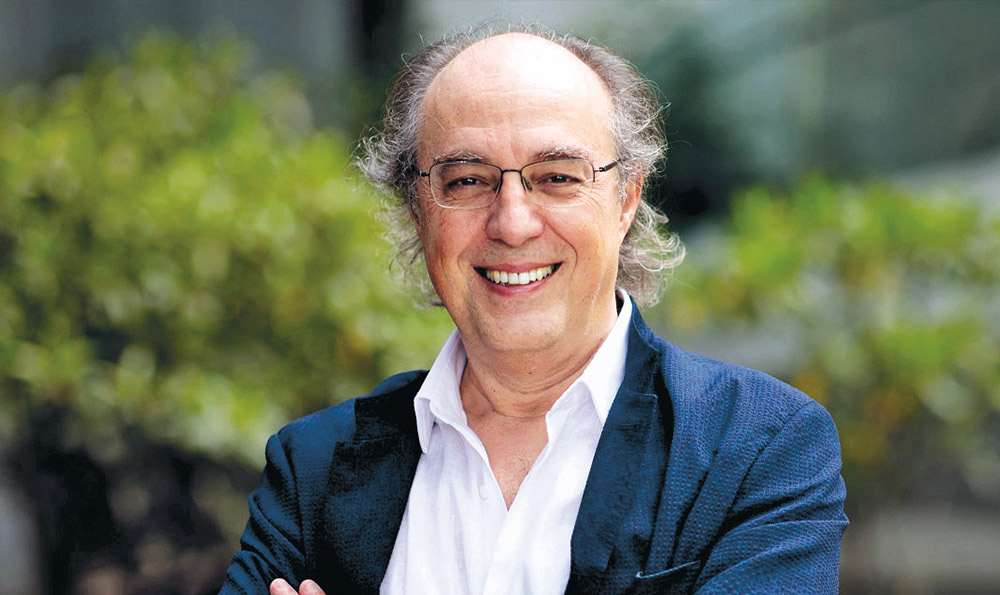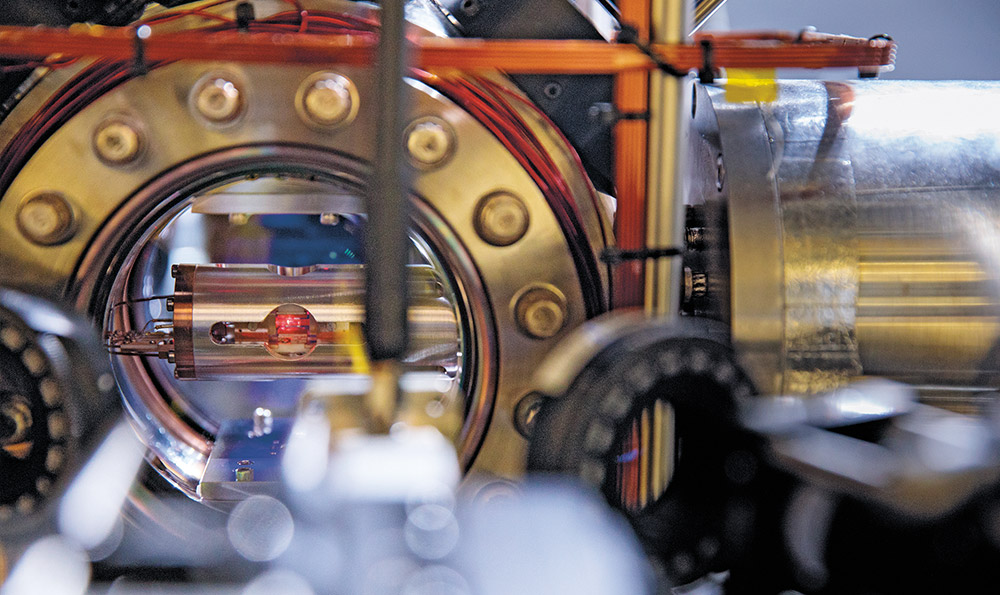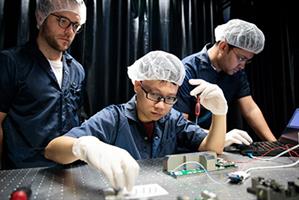Light Speed Ahead!
The new Director of the NUS Centre for Quantum Technologies looks to strengthen its position in cutting-edge research that has huge implications for the future.
A Man of Many Talents
Appointed in July 2020 as Director of NUS’ Centre for Quantum Technologies, Professor José Ignacio Latorre hails from the University of Barcelona, where he is a full professor of theoretical physics. Also appointed Provost’s Chair Professor in the NUS Department of Physics, he has published more than 120 research papers on quantum information and particle physics. The founder of the Centro de Ciencias de Benasque Pedro Pascual, Prof Latorre has produced two documentaries and is also an amateur winemaker.
Granted, it is a tall order to expect the man in the street to be familiar with the fundamentals of quantum computing, but this is the key point about it: Quantum computers perform calculations based on the probability of an object’s state before it is measured (instead of just the 1s and 0s that form the binary code of typical computers). This, simply put, means they have the potential to process data in novel ways compared to classical computers. While classical computing has the bit, quantum computing has the qubit. The qubit stands for ‘quantum bit’, and building it involves a little bit of engineering ‘magic’. Creating qubits can require engineering on a scale that makes even microfabrication seem clumsy, to the level of controlling single particles of light and matter.
Of course, there is more than one way to skin Schrodinger’s cat, so to speak. In other words, there are different methods for making qubits. In the case of the NUS Centre for Quantum Technologies (CQT), researchers are examining the possibility of using trapped ions to create qubits. The team has actually built these traps and can today manipulate individual photons and ions, which requires a phenomenal level of precision. “We have exquisite control of light,” says Professor José Ignacio Latorre, the new Director of CQT. “We can even control one photon and one ion. Can you imagine this? Remember that photons are always travelling at the speed of light, by definition.” Prof Latorre points to the work of Principal Investigator Associate Professor Dzmitry Matsukevich, whose lab is one of a handful investigating the potential of trapped ions at CQT. Last year, Assoc Prof Matsukevich’s team used electric fields to perform computational logic with one ytterbium-171 ion inside a vacuum chamber (ytterbium is a rare earth material). The team is currently improving their trap to enable up to eight such ions to be controlled simultaneously.
PRODIGIOUS LEVELS OF ACCURACY
Quantum computing has been in the news in recent years, especially after Google made its ‘quantum supremacy’ claim (whereby a programmable quantum computer can solve a problem that no classical computer can in a feasible amount of time). Despite all the public attention, quantum technology is more than just about quantum computing. For example, manipulating ions is useful for more than making qubits. Prof Latorre tells us that ions are at the heart of CQT’s ultra-precise atomic clock. This lutetium ion-based optical clock will be accurate to 18 decimal places. That means if this clock were running from the moment of the Big Bang, it would still be accurate to the second right now, some 13.8 billion years later! To offer some context, even the most accurate quartz timers today may gain or lose a second every year.
 Professor José Ignacio Latorre, Director of the NUS Centre for Quantum Technologies.
Professor José Ignacio Latorre, Director of the NUS Centre for Quantum Technologies.
But what might we need such prodigious levels of accuracy for? Prof Latorre says that though we may not have an immediate practical application, the future is built on the instruments developed today. “When Albert Einstein presented general relativity in 1905, you could have argued that there was no practical use for it. Yet today, GPS satellites — indeed all other satellites — with atomic clocks require both general relativity and special relativity to work properly,” he says. Briefly, this is because clocks in motion will run a little differently to clocks that are stationary, relative to each other. Without the equations of general relativity and special relativity, such clocks will never offer the same reading of time. “What many people don’t understand is there is sometimes a gap in time between what you discover and what has a practical application,” says Prof Latorre. “There is a naïve idea that everything you discover, you immediately understand.” For instance, the intervention of cosmic forces showcased a useful application for ultra-precise clocks. The detection of gravitational waves at the Laser Interferometer Gravitational-Wave Observatory (LIGO) in the US in 2016 was made possible, in part, because the researchers could measure distances down to 1/1000th of the width of an atom. This incredible measurement was made possible by an ultra-precise clock.
 Peering into the chamber of this atomic clock in the CQT laboratories reveals the glow of the ions that help deliver its extreme accuracy.
Peering into the chamber of this atomic clock in the CQT laboratories reveals the glow of the ions that help deliver its extreme accuracy.
![]()
What many people don’t understand is there is sometimes a gap in time between what you discover and what has a practical application. There is a naïve idea that everything you discover, you immediately understand.

CQT by the Numbers
Founded in: 2007
Number of staff and students: ~180
Principal investigators: 24
Total number of scientific publications so far: > 2,000
PhD students trained: 85
Quantum spin-offs and startups: 5
BEYOND THE THEORY
A theoretical physicist, Prof Latorre is a passionate advocate for the pursuit of curiosity-driven science. “Basic research is one of the major endeavours of humanity. It’s one of the things that makes us different as a species, that we are able to discover knowledge,” he says. That said, Prof Latorre is a supporter of applied sciences, too. He has scored his own triumphs in the areas of business outreach and entrepreneurship. “As far as applications go, I made my first effort to consult industry leaders on Artificial Intelligence in 1993. I realised at that time that it had potential. I believe we have to try to take the first steps with industries, because the industrial sector doesn’t know what you have developed. That’s why startups here are important,” he says.
CQT certainly has a tradition of encouraging commercial applications. There are already five quantum startups in Singapore associated with CQT. Some are spin-offs that have directly licensed technology developed in CQT while others were founded by alumni. These companies employ over 30 people working on technologies for secure communication, for sensing, and on developing software for quantum computers. In 2019, CQT initiated a partnership with SGInnovate to build partnerships between scientists and entrepreneurs. SGInnovate is a government-owned company that focuses on adding value to Singapore’s deep tech startup ecosystem.
KNOWLEDGE FOR ITS OWN SAKE
Besides nurturing good ideas, and bringing them to the attention of commercial forces, CQT is also engaged in major projects that are good for everyone. Prof Latorre points to the recent (November 2020) news of a significant quantum key distribution (QKD) test in Singapore. This test was not limited to the grounds of CQT, but actually utilised 10km of the country’s network of commercial fibre-optics. “This is a testbed to make the island ready for quantum communication. We are using photons to generate random numbers, which are important for finance. We can set keys that cannot be broken by quantum computers, because they are based on quantum cryptography,” says Prof Latorre.
This demonstration is the latest chapter in a partnership between NUS and Singtel, which owns the fibre network. Researchers from CQT and Singtel successfully deployed entanglement-based QKD at 109 bits per second on the fibre network, thus demonstrating that commercial fibre networks could carry quantum keys too. The key is made and shared by sending pairs of entangled photons through the fibre. The team thinks the fibres may even be able to carry quantum signals and classical internet data traffic at the same time, because the two types of communication can use different wavelengths of light. The NUS-Singtel Cyber Security Research & Development Laboratory is a university-industry partnership set up in 2016 that is supported by the National Research Foundation.
All this bodes well for Prof Latorre, who may be a theoretician but declares that he is an experimentalist at heart. He is certainly a passionate communicator and educator, including in his new capacity at CQT. “Communicating scientific ideas is essential,” he says. For students, he sees university as an opportunity to engage with big ideas. “University is a place where you educate your brain in depth, not just learn a trade,” he says. He also encourages students and society to value the seemingly “uselessness” of some scientific ideas. He retells the story of the invention of magnetic resonance imaging (MRI), now an important tool in healthcare. To detect structures in our bodies, these machines tap the underlying physics of atoms’ energy levels. “Scientific work on the two-level system won four Nobel prizes,” notes Prof Latorre. “It has given us MRI, but in the 1940s they never saw this coming.” One of the Nobel winners, the late Professor Isidor Isaac Rabi, said as much himself when he received an MRI more than 40 years after his prize.